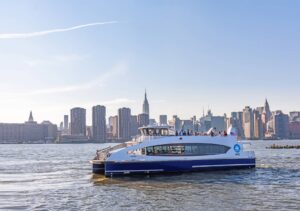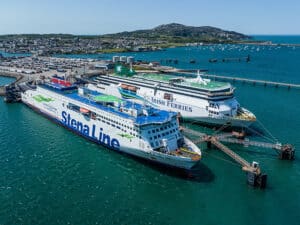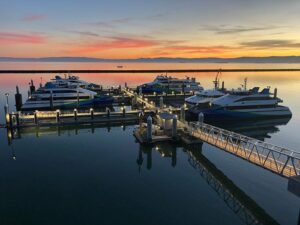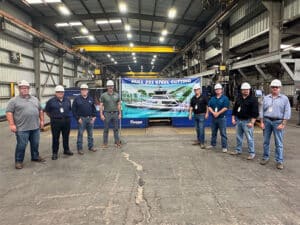
Best Vessels: Distinctive deliveries of 2021
Written by Nick Blenkey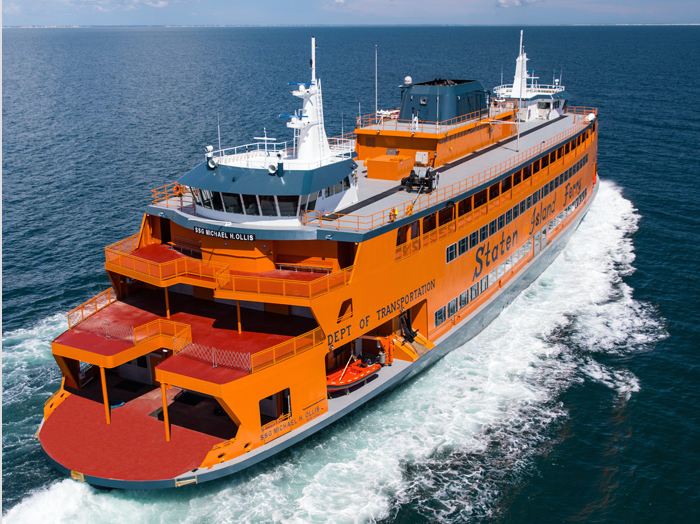
SSG Michael H. Ollis (Credit: Eastern Shipbuilding Group)
SSG Michael H. Ollis: First of three new Staten Island Ferries
Built by Eastern Shipbuilding Group, the 320 foot long by 70 foot beam SSG Michael H. Ollis is the lead ship in a new series of 4,500-passenger ferries built for the Staten Island Ferry Division of New York City’s Department of Transportation (NYCDOT).
Externally, the new vessels are classic Voith Schneider-propelled double enders with the iconic appearance that has made the Staten Island ferries a floating New York City land mark. However, the new ferries are larger, reflect modern technology, and will operate more safely in extreme weather conditions. They feature popular design elements of past Staten Island Ferries and new customer-service amenities such as more comfortable seating and phone-charging outlets and an oval upper-deck promenade that will for the first time serve as an outdoor “walking track” for ferry riders.
They have the latest in marine technology for energy efficiency and environmental friendliness. There are design features on the vessels that are part of the emergency response plan with the city. Lessons from 9/11 were built into this fleet and they can be connected to the New York fire vessels, also built by Eastern Shipbuilding Group, to support evacuations and rescue.
Built to an Elliott Bay Design Group design, the ferry’s main propulsion power is provided by two pairs of Electro-Motive Diesel 12-710 @ 900 rpm EPA Tier 4 marine propulsion engines, with each pair driving a RV6 ECS/285-2 Voith Schneider Propeller via a Reintjes DUP 3000 P combining gear. Electrical power generation is provided by three EPA Tier 3 marine continuous duty diesel generator sets, each comprising a Caterpillar C18 driving a 480 V, 60 Hz, 3-phase generator rated at 425 kW at 0.8 PF @ 1,800 rpm.
Sea Change: America’s first zero-emission hydrogen fuel cell ferry
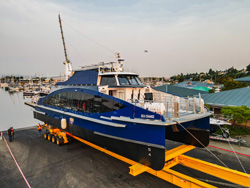
Externally, there’s little to distinguish the 72 feet, 7 inches long by 24 feet, 6 inches wide, 78-passenger Sea Change from any other Incat Crowther-designed Catamaran of similar size. Beneath the skin, it’s a different story.
Recently completed by All American Marine Inc., Bellingham, Wash., the vessel demonstrates a pathway to commercialization for zero-emission hydrogen fuel cell marine technologies.
The project is funded by private capital from vessel owner SWITCH Maritime, an impact investment platform that is building the first fleet of exclusively zero-carbon maritime vessels to accelerate the decarbonization and energy transition of the U.S. maritime sector. SWITCH acquired the vessel, then named Water–Go–Round, from project initiator Golden Gate Zero Emission Marine, now named Zero Emissions Industries (ZEI), in June 2019.
As discussed further in this month’s Tech News section, the vessel’s fuel cells use gaseous, rather than liquid hydrogen. Its ZEI H2FCV1.0 power system includes: 12 rack mounted Cummins 30 kW HD30 low-temperature PEM fuel cells, two 300kW BAE Systems HybriGen Electric Drive Systems and a 100 kWh Xalt lithium-ion battery pack. It carries 242 kg of gaseous hydrogen at 250 Bar in eight Hexagon Composites 224-inch Type 4 tanks and two 95-inch Type 4 tanks from the same manufacturer.
The vessel has been conducting operational trials and will enter service in the San Francisco Bay area once all necessary Coast Guard approvals are completed.
Mardi Gras: First LNG-fueled cruise ship in U.S. market
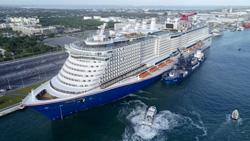
July 31, 2021, marked a double first for Carnival Cruise Line’s new flag ship, Mardi Gras. The 180,000 gt, 1,130-foot ship became the first cruise vessel to sail with passengers from Port Canaveral since the pause in cruise operations 16 months earlier. The 5,282-passenger cruise ship also became the first to make a revenue cruise from a U.S. port fueled by LNG.
Delivered by the Meyer Turku shipyard in Finland in December 2020, the ship has four Caterpillar MaK 16 M 46 DF main engines, which were delivered to the shipyard as floating engineroom unit built by sister Meyer yard Neptun Werft in Rostock, Germany.
Mardi Gras has a 3,600-cubic-meter LNG capacity, sufficient for 14 days of cruising with passengers. LNG not only powers the ship’s four MaK main engines, it’s used for all shipboard systems, from elevators, lighting and computers to galley equipment and, of course, Bolt, the first roller coaster at sea—a feature as likely to attract Carnival customers, as its eco-friendliness.
The ship has a striking new external color scheme that Carnival Cruise Line is now rolling out fleet wide and features six distinct themed zones with a variety of food, beverage and entertainment options.
American Melody: Latest modern riverboat joins American Cruise Lines fleet

Delivered in August by Chesapeake Shipbuilding, Salisbury, Md., American Melody is the fourth in the series of groundbreaking modern riverboats, with which Guilford, Conn.-headquartered American Cruise Lines is putting a new face on American river cruising.
Measuring 269 by 56 feet, American Melody brings its 175 passengers a whole new aesthetic, with an updated interior design that represents the latest evolution in the modern riverboat series. Specifically designed to navigate the Mississippi River, the vessel showcases a gorgeous multi-level sky-lit atrium, spacious indoor and outdoor lounges, a grand dining room as well as a casual outdoor café, a large fitness center, and a spectacular skywalk on the top deck which features an ellipse cutout dramatically cantilevered over the ship’s fourth deck.
American Melody also offers enormous staterooms, singles, and suites ranging from 250 to 650 square feet. All of the spacious staterooms feature full-size bathrooms, roomy closets, and private balconies where guests can enjoy daily breakfast room service.
The success of the modern riverboat series has led American Cruise Lines to bring some of the lessons learned across to its traditional paddlewheel fleet, all of which now carry the distinctive “American” branding in their names, The interiors will be remodeled with designs from Studio DADO, the Miami-based design firm commissioned to do the interiors for American’s newest modern riverboats in a project targeted for completion in time for American’s 2022 cruise season which operates March through December.

